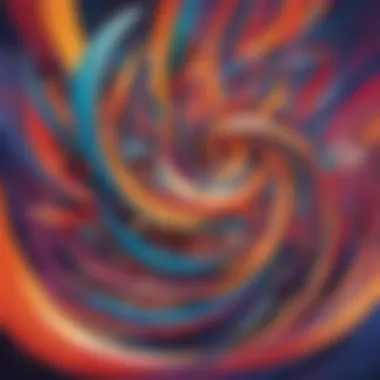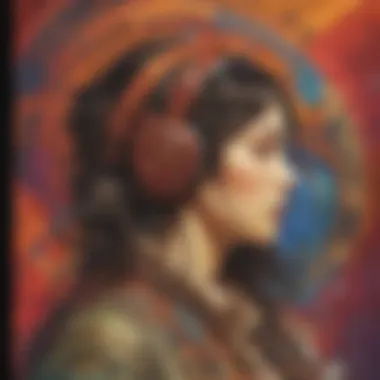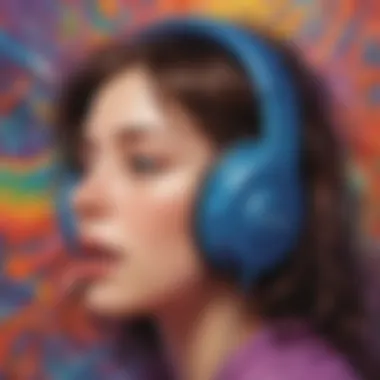Unlocking the Influence of Music Cover Art Design on the Listener's Experience


This article aims to delve into the intricate world of music cover art design to unveil its profound significance in capturing the essence of an album or single. From tracing its historical evolution to dissecting modern trends, we meticulously analyze the pivotal role of cover art in shaping the listener's perception and elevating the overall music experience.
Introduction to Music Cover Art Design
Music cover art design is a crucial aspect in the presentation of albums and singles, playing a vital role in encapsulating the essence of the music it represents. The visual elements of cover art serve as a gateway to the auditory experience, setting the tone and mood for the listener even before the first note is heard. In this article, we will delve into the evolution of cover art through different eras, from the early days of recorded music to the digital age. By examining the purpose and significance of cover art, we can better understand its impact on music marketing and how it influences consumer engagement, sales, and artistic expression.
Evolution of Cover Art
Early Recordings
Early recordings mark the dawn of cover art, with artists using simple designs to distinguish their music from others. These covers often featured basic typography and imagery related to the music genre or themes. While limited in colors and graphics, early recordings set a foundation for future cover art styles, focusing on clarity and direct representation of the music.
Vinyl Era
The vinyl era revolutionized cover art with its large format, allowing for intricate designs and detailed artwork. Vinyl covers became canvases for artistic expression, with iconic visuals like Pink Floyd's 'The Dark Side of the Moon' setting new standards for album artwork. The tactility of vinyl covers added a sensory dimension to music appreciation, enhancing the overall listening experience.
CDs and Digital Age
With the transition to CDs and the digital age, cover art faced new challenges and opportunities. Smaller formats required concise yet impactful designs, leading to innovations in typography and color usage. Digital platforms introduced new interactive possibilities, such as animated covers and augmented reality experiences, reshaping how cover art engages with audiences.
Purpose and Significance
Visual Representation
Visual representation in cover art serves as a visual translation of the music's sound and emotion. By encapsulating the essence of the music in a single image, cover art creates a preliminary connection with the listener, piquing curiosity and setting expectations for the auditory experience.
Brand Identity
Cover art plays a crucial role in establishing and reinforcing an artist's brand identity. Consistent design elements across albums create brand recognition and loyalty among fans. Brands can convey their values and aesthetics through cover art, shaping how their music is perceived in the market.
Aesthetic Appeal
Aesthetic appeal in cover art goes beyond visual charm; it embodies the mood and atmosphere of the music it represents. From minimalist designs to elaborate illustrations, the aesthetic choices in cover art communicate the genre, style, and emotions of the music, making it visually appealing and memorable.
Impact on Music Marketing
Consumer Engagement


Cover art is a powerful tool for consumer engagement, grabbing attention and sparking interest in the music. Visually striking covers stand out in crowded music platforms, drawing listeners to explore new releases. By creating a visual connection with the audience, cover art enhances the overall music discovery experience.
Sales and Promotion
In the competitive music industry, eye-catching cover art can be the tipping point for a listener to choose an album or single. Effective cover designs not only drive initial sales but also contribute to long-term promotion through merchandise and branding. Well-designed cover art increases the marketability of music products, expanding reach and revenue.
Artistic Expression
Cover art allows artists to extend their creative vision beyond music, expressing nuanced themes and narratives visually. Artists can collaborate with visual designers to craft unique and innovative cover art that resonates with their music. The artwork itself becomes a form of artistic expression, enriching the music's storytelling and connecting with listeners on a deeper level.
Elements of Effective Cover Art
Music cover art serves as a visual ambassador for an album or single, conveying crucial information about the music within. In this article, the section on Elements of Effective Cover Art extensively analyzes how typography, color theory, and image selection contribute to the overall impact of cover design. Crafting a standout cover involves a meticulous selection of fonts, colors, and images that resonate with the essence of the music. By exploring these elements in depth, designers can create compelling visuals that pique the audience's curiosity and enhance their listening experience.
Typography and Font Choices
Typography plays a pivotal role in cover art design by setting the tone and communicating the album's personality. Font Selection is a critical aspect that determines the readability and aesthetic appeal of the cover. Choosing fonts that align with the music genre or theme can strengthen the overall visual coherence. Additionally, Text Placement influences the hierarchy of information and guides the viewer's focus. Strategic placement of text elements can create visual balance and draw attention to key details. Font Styling, such as bold, italic, or decorative fonts, adds character to the design. Balancing legibility with creativity is essential to ensure that the typography enhances the visual impact of the cover art.
Font Selection
Font Selection in cover art design directly impacts the mood and perception of the music. Selecting a font that resonates with the genre or message of the album is crucial. For example, a bold and edgy font may complement a rock album, while a sleek, minimalist font might suit electronic music. The unique feature of Font Selection lies in its ability to evoke emotions and convey thematic elements concisely. However, different fonts have varying readability levels, which can influence the effectiveness of communication on the cover.
Text Placement
Text Placement is essential for guiding the viewer's eyes across the cover art effectively. Placing text strategically can create visual hierarchy, emphasizing important information such as the artist's name or album title. However, poor text placement can disrupt the design flow and diminish the overall impact. Balancing text with visual elements is key to ensuring a harmonious composition that captures the viewer's attention.
Font Styling
Font Styling adds personality and visual flair to cover art typography. Whether it's using handwritten scripts for a whimsical feel or bold serifs for a classic touch, font styling contributes to the overall theme and branding of the music. While innovative font styles can make a cover stand out, excessive styling might hinder readability. Designers must strike a balance between creativity and legibility to create an impactful and cohesive visual identity.
Color Theory and Palette Selection
Color theory plays a significant role in evoking emotions and conveying symbolic meanings through cover art. Understanding the psychology of colors helps designers create compelling visuals that resonate with the audience. Color Combination influences the mood and brand identity of the music, with harmonious or contrasting color schemes conveying different tones. Visual Impact is enhanced through thoughtful color choices that engage viewers and reinforce the overall theme of the music.
Psychology of Colors
The Psychology of Colors delves into the emotional and psychological responses elicited by different hues. Choosing colors that align with the mood and message of the music can evoke specific feelings in the audience. For instance, warm tones like red and orange may convey energy and passion, while cool tones like blue and green evoke calmness and tranquility. Understanding the psychological impact of colors empowers designers to create visually arresting cover art that resonates with listeners.
Color Combination


Color Combination is crucial for establishing a cohesive visual narrative in cover art design. Harmonizing colors that complement each other can create a sense of unity and balance within the design. Alternatively, contrasting colors can add visual interest and create dynamic focal points that draw the viewer's gaze. The unique feature of Color Combination lies in its ability to evoke varying emotions and associations, shaping the viewer's perception of the music and artist.
Visual Impact
The Visual Impact of colors on cover art design is undeniable. Colors serve as powerful visual cues that convey mood, genre, and atmosphere, instantly capturing the viewer's attention. Bold and vibrant colors can create a sense of excitement and energy, while muted or monochromatic palettes evoke sophistication and subtlety. By leveraging the visual impact of colors, designers can craft mesmerizing cover art that resonates with the audience and leaves a lasting impression.
Image Selection and Composition
The selection and composition of images play a vital role in defining the visual identity of music cover art. Whether using photography or illustration, designers must consider how artwork placement and image quality enhance the overall aesthetics of the cover. By carefully curating visuals that align with the music's theme, designers can create immersive cover art experiences that captivate and intrigue the audience.
Photography vs. Illustration
Choosing between Photography and Illustration involves determining the appropriate visual style that complements the music. Photography offers a sense of realism and authenticity, capturing moments that resonate emotionally with the audience. On the other hand, Illustration allows for creative interpretation and imaginative storytelling, presenting abstract concepts or surreal imagery. Understanding when to use photography or illustration is essential for conveying the right message and eliciting the desired response from viewers.
Artwork Placement
Artwork Placement plays a key role in guiding the viewer's eye and creating visual impact. Placing artwork strategically can enhance the overall composition, directing attention to essential elements while maintaining a cohesive design flow. The placement of images in relation to text and other visual elements influences the balance and readability of the cover. Designers must consider how artwork placement affects the viewer's perception and engagement with the music.
Image Quality
Image Quality directly affects the clarity and visual appeal of cover art. High-quality images enhance the professionalism and aesthetics of the design, capturing detail and texture with precision. On the contrary, poor image quality can detract from the overall impact and leave a negative impression on the audience. Selecting images with optimal resolution and sharpness ensures that the cover art maintains its integrity across different mediums and sizes, contributing to a captivating and immersive visual experience.
Trends in Music Cover Art Design
In this section, we will explore the crucial aspects of Trends in Music Cover Art Design within the context of music cover art. The aesthetic evolution within cover art plays a significant role in capturing the essence of music albums or singles, shaping the audience's perception and enhancing their overall auditory experience. To delve deeper, we will examine specific elements such as design innovations, stylistic preferences, and consumer preferences that contribute to the ever-evolving trends in music cover art design.
Minimalism and Simplicity
Clean Lines
Clean lines are a fundamental aspect of minimalism in cover art design. The simplicity and precision of clean lines offer a sense of clarity and elegance to the visual representation of an album or single. Artists often leverage clean lines to convey a sleek and modern aesthetic, drawing the audience's attention to the core elements of the design. These lines, devoid of distractions, create a sense of balance and sophistication that aligns with the subtle complexities of the music within. While the popularity of clean lines continues to grow, their understated nature can sometimes lack the dynamism desired for more vibrant genres or expressive themes.
Subtle Details
In the realm of cover art design, subtle details play a pivotal role in adding depth and nuance to the visual composition. These details, though delicate, carry significant meaning and symbolism that enrich the overall narrative of the music artwork. Whether through intricate patterns, hidden symbols, or nuanced textures, subtle details invite the audience to embark on a visual journey of discovery, reflecting the intricacies and layers present in the music itself. While these details enhance the overall aesthetic appeal and encourage deeper engagement, their understated nature may be overlooked by casual viewers at first glance.
Negative Space
Negative space, also known as white space, is a powerful tool in design that focuses on the intentional empty areas within an artwork. This strategic use of negative space allows the music cover art to breathe, emphasizing the central elements and creating a sense of openness and minimalism. By judiciously leveraging negative space, artists can impact the overall composition's balance, drawing attention to specific focal points and enhancing visual impact. However, excessive negative space runs the risk of appearing stark or uninviting, demanding a careful balance to maintain aesthetic appeal and communicate the intended message effectively.


Case Studies and Examples
In the world of music cover art design, case studies and examples play a pivotal role in showcasing the impact and significance of visual representation on music perception. By studying iconic cover artworks, we can understand how design choices influence brand identity, consumer engagement, and overall sales. Case studies provide tangible examples of how artistic expression through cover art can transcend time and resonate with audiences across generations.
Iconic Cover Artworks
The Beatles - Abbey Road
The Beatles' 'Abbey Road' cover stands out as a timeless masterpiece that encapsulates the essence of the band's music and era. Its iconic zebra crossing photo captures a moment of harmony and artistic simplicity, creating a lasting impression on viewers. The distinctive feature of 'Abbey Road' lies in its ability to symbolize unity and musical legacy, making it a popular choice for discussions on cover art's role in conveying emotions and stories.
Pink Floyd - The Dark Side of the Moon
'Pink Floyd - The Dark Side of the Moon' is a groundbreaking cover art known for its mesmerizing prism design. This cover art's key characteristic lies in its ability to represent abstract concepts such as time, light, and sound in a visually captivating manner. The unique feature of 'The Dark Side of the Moon' lies in its minimalistic yet profound symbolism, making it a compelling choice to illustrate the fusion of art and music.
Nirvana - Nevermind
Nirvana's 'Nevermind' cover challenges conventional norms with its raw portrayal of a baby swimming underwater. The key characteristic of 'Nevermind' lies in its confrontational imagery, sparking discussions on the boundaries of controversial art in music. The unique feature of 'Nevermind' is its ability to provoke thought and debate, adding layers of complexity to cover art interpretation and artistic expression.
Controversial Cover Designs
Sexual Imagery
Sexual imagery in cover art design serves to push boundaries and ignite conversations about sensuality, aesthetics, and societal taboos. The key characteristic of utilizing sexual imagery lies in its ability to capture attention, evoke emotions, and challenge conventional norms of censorship and artistic freedom. Despite its controversy, sexual imagery can be a strategic choice to provoke thought and spark dialogues on cultural perceptions and artistic interpretations.
Political Statements
Cover art featuring political statements serves as a powerful platform for artists to voice social commentary, ideologies, and resistance movements. The key characteristic of incorporating political statements lies in its ability to communicate dissent, advocacy, and awareness through visual symbolism. While polarizing, political statements in cover art can engage audiences in critical discourse, fostering dialogue on activism, power dynamics, and artistic influence.
Shock Value
The use of shock value in cover designs aims to provoke, challenge, or disrupt viewers' expectations, norms, and comfort zones. The key characteristic of shock value lies in its capacity to evoke strong emotional responses, confront societal norms, and stimulate critical thinking. Despite its divisive nature, shock value can be a deliberate choice to captivate audiences, initiate dialogue on controversial topics, and challenge perceptions of artistic expression and societal constructs.
Innovative Modern Approaches
Animated Covers
Animated covers revolutionize traditional static designs by introducing dynamic visuals that enhance interactivity and storytelling. The key characteristic of animated covers lies in their ability to captivate audiences through motion graphics, visual effects, and narrative progression. The unique feature of animated covers offers immersive experiences, enabling listeners to engage with music on a multi-sensory level and explore innovative realms merging technology with artistic expression.
Limited Edition Packaging
Limited edition packaging elevates cover art to a collector's item status, inviting exclusivity and rarity into music consumption. The key characteristic of limited edition packaging lies in its capacity to entice collectors, superfans, and enthusiasts with unique materials, designs, and bonus content. The unique feature of limited edition packaging enhances the physical connection between music artists and listeners, fostering appreciation for craftsmanship, detail, and limited-edition artistry.
Personalized Artwork
Personalized artwork in cover design offers a bespoke and intimate touch, catering to individual preferences, aesthetics, and fan connections. The key characteristic of personalized artwork lies in its ability to create emotional resonance, nostalgia, and personalization in music branding. The unique feature of personalized artwork establishes a direct bond between artists and audiences, fostering loyalty, engagement, and a sense of exclusivity in the music listening experience.















